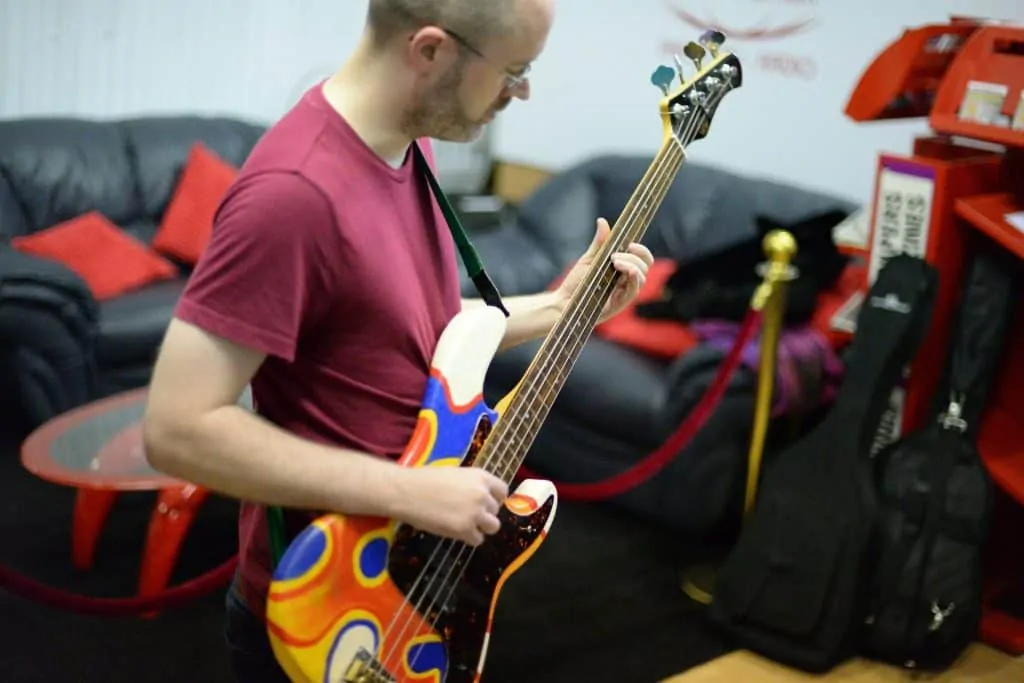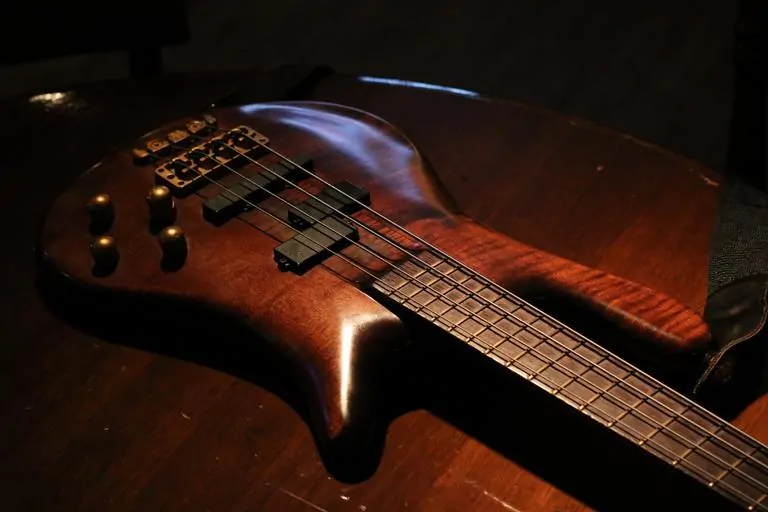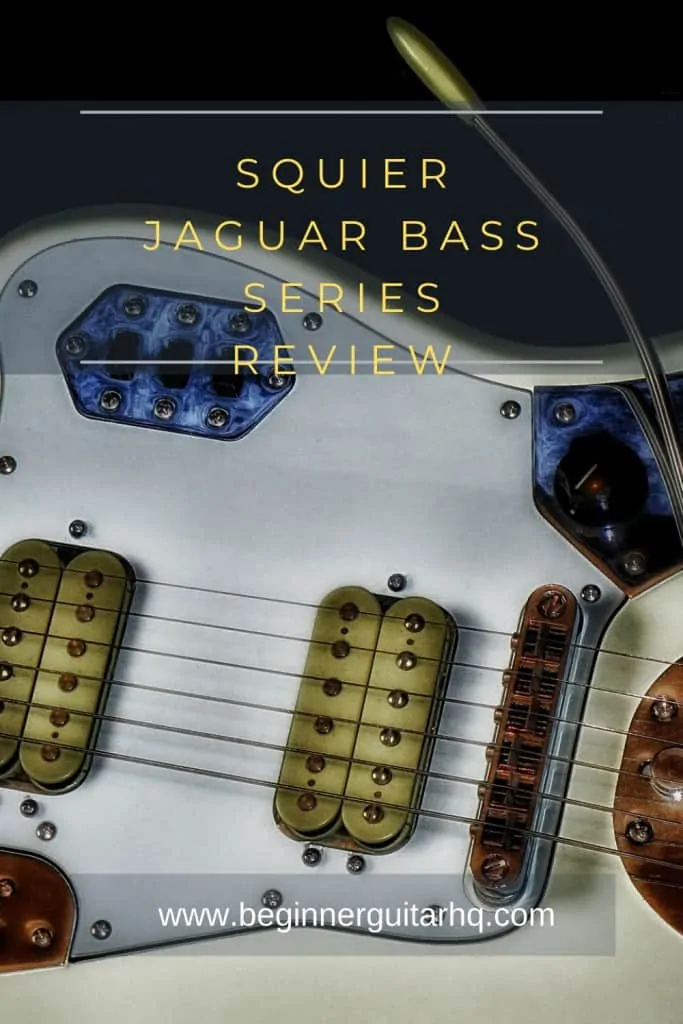What’s so special about the Squier Jaguar bass?
The Fender Jaguar bass is a very special instrument manufactured by Fender Japan and Fender Chine. The Squier by Fender Jaguar is a more affordable version of this modern bass, and I’m here to help you understand everything about the series.
So I’m going to help you choose some amazing items from the series. In summary, you need to know the Squier Jaguar bass series is full of affordable, beginner-friendly, modern basses with superb versatility and a punchy sound for modern rock and pop genres.
I must add that Fender bought Squier Musical Instrument Company back in 1965. Since then, Squier has gone through several changes until it was introduced into the world in 1982 with a new line of inexpensive alternatives to the premium USA-made Fender instruments.
The company’s idea remains the same since they first opened shop. They build friendly instruments for the budding musician and offer secondary instruments to an already made professional guitar or bass rig.
Yes, Squier has a bad reputation and is known for cutting corners in order to lower the prices. However, they’ve enhanced the quality of their products in the past couple of years, so modern Squier instruments are way better than what you expect.
Meaning the quality of Squier instruments continues to rise with the years, and their shelves have exploded with a wide array of new models, options, pickups, and designs. Remember, many times, what you buy in brands like Fender and Gibson is the name of the brand itself, and these priced instruments are not light years away from their affordable counterparts. At least not as their prices want to make you think
By the way, if you need some help choosing a beginner bass guitar, here’s a buyer’s guide you can check.

We’re covering the two active basses of the series with a review. These basses are:
- Squier by Fender Vintage Modified Jaguar Bass Special SS.
- Squier by Fender Vintage Modified Jaguar Bass V Special (it has 5 strings).
You may also find an additional Squier Jaguar bass out there, which is the Squier by Fender Classic Vibe Jaguar Bass. However, this model is no longer on Fender’s shelves or listed in its online store. It’s discontinued and, to be honest, it’s not a particularly good instrument. At least not like the other two.
Contents
Jaguar Bass series history
Fender introduced the Jazz Bass in 1960 with the name “Deluxe Model,” as in it was the premium version of the previously released Precision bass.
The company marketed the new bass as a pair to the premium USA Fender Stratocaster electric guitar. In particular, because it had a narrower neck that appealed to jazz player.
In 1961, Fender released the Bass VI, which had a short-scale neck and six strings. Additionally, it had a switch to change between pickups. The Bass VI was the precursor of the Fender Jaguar released in 1963.
In 1975, Fender decided to discontinue both the Bass VI and the Jaguar bass. In parallel, they released the Jaguar electric guitar, which became so popular Fender then revived the Jaguar bass in 1999.
Furthermore, Fender produced the Jaguar Bass VI Custom from 2004 to 2006, which is a mix between the Jaguar and the Bass VI.
The design of the Squier Jaguar Bass series
The Squier Jaguar bass resembles the design of the original Fender Jaguar. However, Squier’s version took the neck, bridge, and pickups from both the Fender Precision and the Fender Jazz bass. It means that, in a way, the Squier Jaguar Bass works like Fender P/J special basses, which mixes parts from the two Fender models to offer the best of both worlds.
The Jaguar Bass is a cool instrument that sets itself apart with its ‘60s-style, versatility, and fast Jazz Bass feel.
The pickups vary in each model. Keep in mind these are mostly active bass pickups similar to the Fender P-bass pickups.
Additional features covering all Squier Jaguar models include a C-shaped maple neck, 20 medium-jumbo freet, and 7-25’’-radius rosewood fretboard. Furthermore, this is a short scale bass is its length is 32’’ average neck to head. The size of the jaguar bass, though, varies with each model of the series.
This makes for a medium bass: not too heavy, not to light, and capable of producing decent enough sounds on the lower end of the scale.
The Squier Jaguar pickup configuration is much like a P/J bass.
The controls of the Jaguar bass series
The controls of the Jaguar Bass series is where we find the gist of this lineup.
First of all, the original Jaguar Bass has a total of eight onboard controls, just like the original 1963 Jaguar. It’s the most elaborate control layout ever on a Fender bass:
- 4 slider switches;
- 2 inset control wheels;
- 2 standard knobs (master volume and master tone).
Let’s get something clear: these controls belong to the Fender Jaguar Bass. We’ll review the Squier version later on.
Bass players are used to two or three-knob controls, which are usually master volume and individual tone knobs for each pickup. So I would expect this amount of controls seems like a hassle. However, this unusual electronics system gives the Jaguar Bass series a unique identity.
Here’s an explanation of what these switches and buttons can do:
Be sure to read and watch the video if you want a Jaguar bass because there’re no manuals available out there. Let’s break it down:
- The first pickup selector is down, on the right side of the bass guitar’s body. It’s a chrome plate with three slider switches. The first switch is the on/off button for the neck pickup; the middle one is the on/off control for the bridge pickup, and the third switch selects between wiring or parallel series pickups.
If you turn this switch up (towards the strings), you select pickups in series, which gives you more output and a louder sound. On the contrary, it delivers a Jazz bass sound. This only works when the bridge pickup is on.
There’re two large rotary knobs close to the input jack. These are the master volume and the master tone.
- The chrome plate on the upper side has a single switch plus two control wheels. The switch toggles active or passive circuits (active in the upper position).
Then, the wheels are active bass cut and active treble cut, so they work only when you select the active circuit.
- You have the master tone and master volume knobs as usual.
As you see, there’s a lot going on aboard the Jaguar Bass. It means you need to take some time familiarizing yourself with all these controls to really understand its potential.
There’re some variations. For example, the Squier Vintage Modified Jaguar Bass Special SS has one individual tone knob and volume control knobs for each of the two pickups. Other models are more beginner-friendly, as their sole controls are the master volume and tone controls.
The Squier Vintage Modified Jaguar Bass V Special carries individual volume knobs for each pickup plus a master tone and a bass boost knob. This boost goes especially well with this bass because the V Special added the 5th string, which is a lower B.
It means you still have plenty of tonal control with the Vintage Modified Squier Jaguar Bass series. These ones feature a straightforward setup.
With the volume controls, you can turn pickups on and off to adjust the sound. I usually recommend keeping the pickup volume lower than the neck pickup as that gives you a nice, warm tone that eliminates background noise and feedback.
Furthermore, because you have individual volume knobs, you can turn on and off specific pickups, just like the Fender Jaguar bass can.
And then, the Squier Classic Vibe Jaguar Bass is the simplest one as it only has master volume and master tone knobs.
Lastly, there’s an additional defining feature of the Squier Jaguar series. The tone knobs have adjustable positions you can click. It allows you to recall the exact tonality you want at any time as if it was a stored preset. It also avoids moving the tone knobs accidentally.
The Squier Jaguar bass series has more control and versatility than any other Squier bass. That doesn’t mean it’s necessarily better, though, as you might prefer specific tones rather than exploring possibilities.
The tone of the Squier Jaguar Bass series
The basic tone of the Squier Jaguar bass is very similar to a Fender Jazz bass with an amazing add-on. When you add some gain, power, overdrive or distortion, it will deliver a “growl” similar to what a P-bass can give.
Overall, this great bass for playing with your fingers, and has enough versatility to play most modern genres. Rock, hard rock, pop-rock, rock, reggae, modern jazz, Latin music, and more. However, I don’t recommend these models for heavy metal.
I heavily recommend the Squier Jaguar series because of how much versatility it offers for the price it costs. It can go from Motown R&B to prison blues to modern rocks. More so, the controls are easy and intuitive, which means you’ll be able to reach your desired sound with a flick of your fingers.
I would describe the overall tone as “carnivorous.” It’s a quite balanced tone that lets loose on funk and rock songs and holds back on softer music genres.
The feature I find most impressive is the interplay between the dual tone and volume control, which is the most defining feature of the Squier Jaguar series. It allows you to travel along with genres seamlessly and dial back. I also love how close these knobs are from your picking hand.
The high tones are warm and the middle tones are brittle. Noise and background hums are nonexistent, although you may experience some feedback when you stand to close to the amp.
My least favorite Jaguar bass of the series is the Special SS because it offers a wide array of tones which are quite different from the Vintage Modified. These tones are looser and “bassier” as it has a naturally low-end tone with some fullness and sustains on the mids.
However, the sound but harder to keep tight: if you don’t mix it and match it with the right amp and effects, you will quickly lose the quality of its tone. More so, I recommend you play the Special SS with your fingers instead of the pick, as that lighter touch does the difference.
As for pickups, the Special SS has a fat and powerful neck pickup, but a thin and sub-par bridge pickup.
In general, the tone is very similar to what the Fender Jaguar series offer, although it has fewer controls and thus a bit less versatility. I must then add Troy Sanders, bassist and singer of progressive rock band Mastodon, uses a signature Jaguar bass.
Why should you get a Squier Jaguar bass?
The Jaguar series, as you see, is a modern balance between the old-school jazz sound and the most modern solutions the P-bass packs.
Its design is really attractive, and anything that draws people towards the world of bass is a good thing.
And although the Squier versions don’t pack the same level of tonal versatility, they still carry enough punch with its individual volume controls. Plus, it looks really cool with its sleek ‘60s inspired design.
I also love that this is a line of short-scale instruments that are popular amongst bassist players who find it too hard to navigate on the fret. Manufacturers were quick to recognize this, and that’s why the number of short-scale models has increased in the past years.
Fender joined the party of short scale basses in particular with the 30’’ scale Vintage Modified Jaguar selling for an entry-level price. This is the perfect choice for beginners and young guitar players looking for ease of use.
Remember short-scale basses often compromise in tone because the length of their strings loses some strength.
Squier Jaguar bass guitars offer a serious bite. They represent an affordable entry to the world of professional bass guitars. Although they are not as strong, crispy and smooth as USA-made Fender Jazz and Precision basses, coupled with a good amp (which we cover on the last section) they are perfectly ok for your gigs and recording music at, at least, an EP level.
So, if you’re starting out, the Squier Jaguar series offers an interesting, balanced sound, tonal versatility with a pretty easy setup, and an affordable price.
In summary, you can buy a Squier Jaguar bass if you need an inexpensive alternative to the expensive USA-made Fender basses, or if you need a solid backup instrument or an instrument to complement your musical journey.
I recommend going for the Vintage Modified options rather than the Classic Vibe Jaguar.
If you need further help to choose a budget bass guitar, here’s a budget bass guide.
A good budget bass would give you a nice tone for recording and playing live whilst keeping hums and noises at bay. Plus, it would have a friendly price tag.
Review of the Squier Jaguar Bass series
Coming up, I’m reviewing the Vintage Modified models of the Squier Jaguar basses, because, although you can still find the Classic Vibe on Amazon, Squier already discontinued the said model.
The company decided to discontinue the Classic Vibe Jaguar because it simply doesn’t offer much in terms of versatility. Even so, it packs the same design, electronics, materials, and pickup configuration as the models below.
More so, this is also a short-scale bass, much like the model down below.
Squier Vintage Modified Jaguar Bass Special SS
The Squier Vintage Modified Jaguar is an attractive instrument. This is an all-new short-scale bass with a design inspired by 70s-era Fender basses. It’s sharp-looking, very versatile, and sells for a mid-level price.
This is more than just a model for students. It’s a great bass for players who can appreciate the comfort and portability of short-scale basses, and great for all-hands bassists looking for tone versatility and smooth playability.
It has 22 frets and a 9.5’’ maple neck that’s comfortable and smooth. Plus, it has no sharp ends striking out the fret.
As this is a short-scale bass, it’s not a heavy instrument. Although it does carry some weight when you slung it on a strap over your shoulders. However, the weight is very balanced and manageable.
Short scale basses are very beginner-friendly. However, seasoned players can also gravitate towards them because of their warmer tone, soft low-end, and subdued highs. Plus, they are easier for players with short fingers or small hands, and for guitar players used to traditional guitar axes.
Pickup configuration and controls
Two Seymour Duncan-designed pickups handle the sound. It has a Jazz bass single-coil (JB102B), which is made of alnico and offers a vintage tone. And it has a split single-coil Precision pickup (PB101), which also uses alnico material.
The pickup configuration is much like P/J basses, which are a mix of the Jazz and the Precision bass.
These pickups alone are worth getting the bass, plus the control you get with this bass will make your life easy. See, the tone knob alters the tone in several notched positions you can “click,” as I said before. Many people would want to leave these tone controls set in a perfect sweet spot and forget about moving it by accident. More so, these “click” positions allow you to recall your tones at a moment’s notice.
You can also control the output of each pickup with its individual knobs. That means it has two individual volume controls (one for each pickup) plus a tone knob with adjustable positions.
Sound and playability
First of all, short-scale instruments are very popular because of how easy they are to play. The neck is shorter, the strings are shorter, and the bass is lighter. However, the space between the frets is tight, and that might represent either an advantage or a disadvantage for you.
The sound is punchy and responsive. Right out of the cage, the pickup’s tone is solid, resonant and brilliant.
The neck, which has the split-coil, gives the bass a rounded and warm bottom end and some low-mid punch. And the bridge single coil has a brighter tone with some midrange honk.
The “tonal palette” offers many possibilities, from dark tones to a softer sound. As you roll it off, the bass gives you a fatter, warmer signal. The other way around delivers a brighter sound.
It gives you enough space to play most modern rock jazz, and Latin-music genres, although reggae, dub, blues and soul players.
In summary, the sound is not as different as a long-scale bass with a similar pickup configuration. The only difference comes in the physical nature of the instrument.
I can see how this Jaguar bass can appeal to beginners or as a practice bag. The Squier brand carries a bad reputation, but I advise you to take each instrument as an individual being.
If possible, try it out and see how its weight, tone, and performance suits you. There are some cuts made here and there, but for the price it costs, you can surely find some value in it.
As a verdict, this is a versatile, comfortable bass that produces a nice blend between the Fender Precision and the Fender Jazz basses.
I have to add there’s also a long-scale model which is 34’’ in length. However, this model is currently discontinued.
Build quality
This bass is made in Indonesia, which is why the used a cheap timber as its tonewood (agathis). However, it stills fulfills the purpose of this bass.
The design is unusual in many ways. For instance, its three-ply pickguard has an odd shape, and some of its visible components seem to be low-budget, like the Fender-style bridge.
On the good side, we have a four-bolt neck which is a very tight and quality connection. More so, the C-shaped neck offers a sleek feel and playability.
Overall, it feels similar to a Jazz bass, and it has a nice response and no sharp fret ends.
Additional info:
- Neck: C-shaped maple neck
- Fretboard: 9.5’’ radius rosewood fretboard.
-
- 20 medium-jumbo frets with very smooth edges.
- Tonewood: agathis with a silver finish.
- Scale: short scale (30’’)
- Pickups: single-coil J-bass bridge pickup; vintage split-coil P-Bass middle pickup.
- Controls: individual control knobs for each pickup plus a master tone knob.
Squier Vintage Modified Jaguar Bass V Special
The Squier Bass V Special is similar to its predecessor, the original Jaguar, and carries the same P/J pickup configuration.
It has a sleek offset-waist body that’s comfortable when you play ii and very aesthetic. It features a modern C-shaped neck for performance and comfort, plus a smooth black finish ideal for those who play with the thumb or on the side or back of the neck.
The difference between this bass and the Squier Vintage Modified Jaguar Special is the bass power and the scale. See, this is a long-scale bass with a 5th string (which is the lower B). It means this has the capacity of playing deeper and going further down the scale. More so, because it has a long scale, the tone generally enhances low-end frequencies, with a little punch on the mids and warmth on the highs.
I must also add that long-scale basses (especially 5-string basses) are not suited for beginners. This bass is for experienced, adult players who can handle the weight and the size of the instrument.
This V model is my favorite 5-string budget bass available right now. Keep in mind most 5-strings basses at this price range have a really floppy 5th string (which is always the lower B). However,
Pickup configuration and controls
The P/J configuration includes two Fender-designed pickups. It has a single-coil Jazz Bass pickup on the neck, plus a split-cingle-coil Precision Bass V in the middle.
The controls include an active bass-boost circuit knob, plus volume knobs for each pickup and a master tone knob.
The bass boost knob gives you extra juicy low-end tones. As you turn the knob, the bass will give you a fatter, more acid sound, and you can tweak the general output of the bass with the volume knobs. This combination gives you greater control and strength than the prior bass, so the Jaguar Bass V by Squier has even more versatility and can serve well for blues, R&B, soul, and even metal genres.
Sound and playability
This is currently Squier’s most versatile bass, something that mixes really well with the add-on of a 5th string.
Its sharp look comes with a fantastic, strong tone, and although this is a long-scale instrument, it feels comfortable and balanced on your shoulders.
Build quality
The build quality is the same as the prior model, so I have nothing new to add to this section.
Additional info:
- Neck: C-shaped maple neck
- Fretboard: 9.5’’ radius rosewood fretboard.
-
- 20 medium-jumbo frets with very smooth edges.
- Tonewood: basswood with a silver finish.
- Scale: long-scale (34’’)
- Pickups: single-coil J-bass bridge pickup; vintage split-coil P-Bass middle pickup.
- Controls: individual control knobs for each pickup plus a master tone knob and an active bass boost knob.
The best, affordable bass amp for the Squier Vintage Modified Jaguar basses?
The amp brand I personally recommend for this series is Ampeg.
In particular, you can go for an Ampeg BA115T combo, which sells for about the same price as the bass.
This is a 150 W amp with plenty of sound quality or power for rehearsals and the stage. Even so, it’s small and portable enough to carry around and keep it in your room for practice. It can also be capable of amplifying your bass on small gigs.
Furthermore, you can go for a smaller version of the amp if your budget is tight. There’s a 40W version, a 75W version, and a 400W version. I find 150W just the perfect size.
Final considerations
Who would buy a Squier Vintage Modified Jaguar bass?
I can say the Squier’s Vintage Modified Jaguar basses are quite popular with both beginner and intermediate players and for good reasons. The quality of this lineup has increased a lot in recent years, so now they can hold their ground on stage and the studio.
This is an affordable bass with great design, great construction, and a solid, punchy tone. In fact, the level of quality it offers for the price is hard to beat.
As my final word, I have to add I always find Squier bass tones somehow similar. They are crispy, clean, and smooth. However, I always think they lack lows. What’s your thought on Squier basses? Leave the comments below!
Here’s the last review video I want to show you. It’s a great review of the Squier Vintage Modified Jaguar Special bass. You’ll hear how, most definitely, the Squier Jaguar is a superb budget bass for playing rock, punk and funk genres. And that’s my final say.




